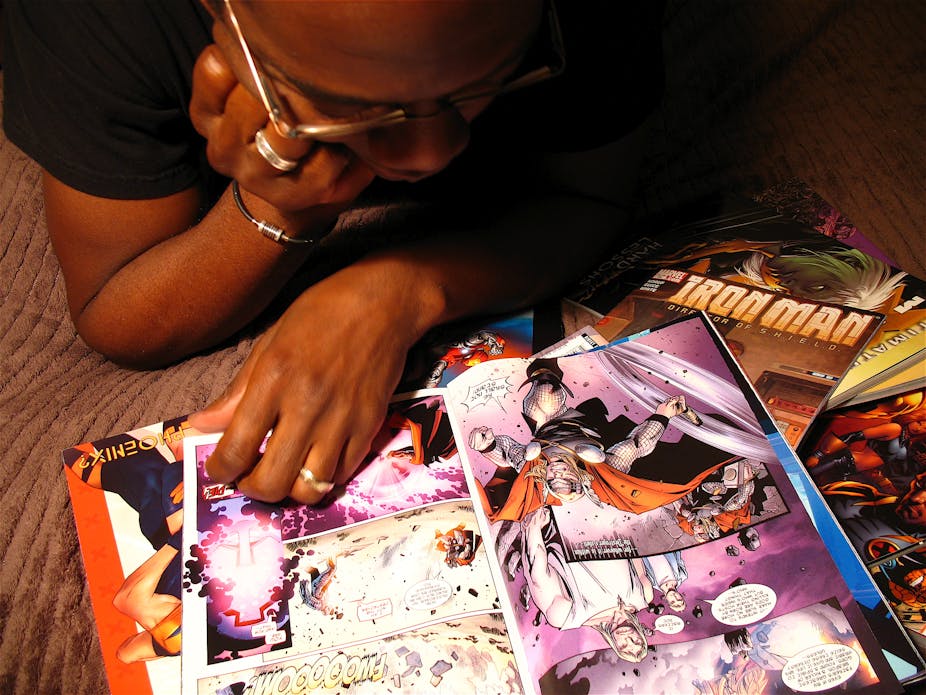For the second year running, the Edinburgh International Book Festival returns with Stripped 2014; a strand dedicated exclusively to comics and graphic novels. It has even commissioned its own graphic novel – a dystopian vision of Scotland’s future called IDP:2043 – as a centrepiece. But this absorption of comic books into a culturally highbrow setting should not go unquestioned.
A few years ago I attended a public interview featuring David Simon, creator of the critically acclaimed HBO television series The Wire. Simon’s questioner, a seemingly beleaguered broadsheet journalist, started off by comparing the series to “a novel”; Simon seemed puzzled by the comparison and asked the journalist to elaborate. The Wire was like a novel, the journalist explained, because it was a text of “high quality”. Simon rejected the comparison but the journalist, who also referred to Freeview cable services which, at that time, did not broadcast The Wire, as “council-house telly”, returned to it repeatedly during the interview.
Clearly, for this journalist, the novel occupies a prestigious position in a hierarchy of forms, and so to compare a TV series to a novel is to identify it as a form of superior television. By doing so, however, and by making his asinine remark about Freeview, he reinforces the notion that a “high-quality” text can only be enjoyed by a similarly sophisticated audience. It seems to me that something similar often happens when comics are discussed as “graphic novels”.
Bourgeois books
I have always disliked the term. It seems to me more appropriate for discussing texts like Lady Chatterley’s Lover or Fifty Shades of Grey than long-form sequential art narratives. I have found that it is often used in an attempt to elevate certain comics, and their readers, to a more legitimate social position. Deploying the notion of the novel in this way demonstrates an ignorance of its cultural history.
After all, the novel as we know it today only achieved pre-eminence relatively recently, beginning in the 18th century. Hitherto it was considered inferior to poetry and drama, and was seen to be a form of entertainment for the lower classes, rather than “serious” literature. The novel rose to its current status in parallel with the rise of the bourgeoisie, for whom it became their indigenous literary form.
Alan Moore, one of the best-known and most highly regarded writers in the comics field, has remarked that growing up in Britain in the 1950s and 1960s, comics were “just something you have, like rickets”. In this comment, the association of a lowly textual form with a lowly social class -– rickets being a condition associated in Britain with the working class -– is explicit. Moore is credited with bringing depth and maturity to comics with his “revisionist” superhero series Watchmen, illustrated by Dave Gibbons, which attempted to present a realist view of the superhero genre.
Vertigo
Watchmen, along with Frank Miller’s The Dark Knight Returns – which offered a similarly “gritty” take on Batman – received significant attention from the mainstream media with the phrase “comics aren’t just for kids anymore” being used regularly. In 1993, its success, along with Moore’s “revisionist” take on the 1970s monster character Swamp Thing, led to the creation of Vertigo, an imprint of DC comics with the aim of providing “sophisticated suspense” for “mature readers”.
While Moore himself did not write for Vertigo, the imprint was responsible for advancing the careers of several other British writers, most notably Neil Gaiman and Grant Morrison whose The Sandman and Doom Patrol series, respectively, offered radical re-interpretations of existing DC characters which challenged and ultimately redefined the superhero genre.
Gaiman in particular was marketed by Vertigo, and by himself, as a novelist who just so happened to be working in the comic book field; Gaiman’s image as a “serious” writer was further emphasised by the forewords and endorsements from prose novelists which accompanied the collected editions of The Sandman, including Norman Mailer’s description of the series as “a comic strip for intellectuals” and by the appearance of Shakespeare in the comic where he was represented as producing high-quality, popular fiction – much like Gaiman himself.
Morrison’s Doom Patrol lent its title to the academic Steven Shaviro’s “theoretical fiction about postmodernism”, Doom Patrols, in which he describes the consumption of comics as being “all so different from the habits of highbrow literary culture”. This is because, Shaviro argues, a “comic has fans more than it does ‘readers’.” Today, of course, fandom, particularly of “geek culture” such as comic books and science fiction, has permeated mainstream culture, as is evident in the massive success of Marvel Studios’ range of superhero blockbuster movies, including The Avengers and the Iron Man trilogy, and the growth in sales of comics in both single-issue and collected form.
But this success of comics has also increased the amount of “readers” who seek to identify, as Simon’s interviewer did, some intellectual merit in comic books. This is particularly true in academia, where comparative literature programmes place comics alongside works of literary and popular prose fiction. On the surface this appears to be a progressive step, but I wonder whether this inclusion, and seeming elevation, of comic books is not in fact a reduction.
In being absorbed into highbrow literary discourse, the comic book form is often treated, at best, as a version of the prose novel. The power structures that underpin notions of “quality” and “legitimacy” are also reduced to simple “facts of life”. I am not saying that comic books aren’t worthy of academic enquiry – everything is – but they should be taken on their own terms and not those of established literary criticism. They require no elevation.

